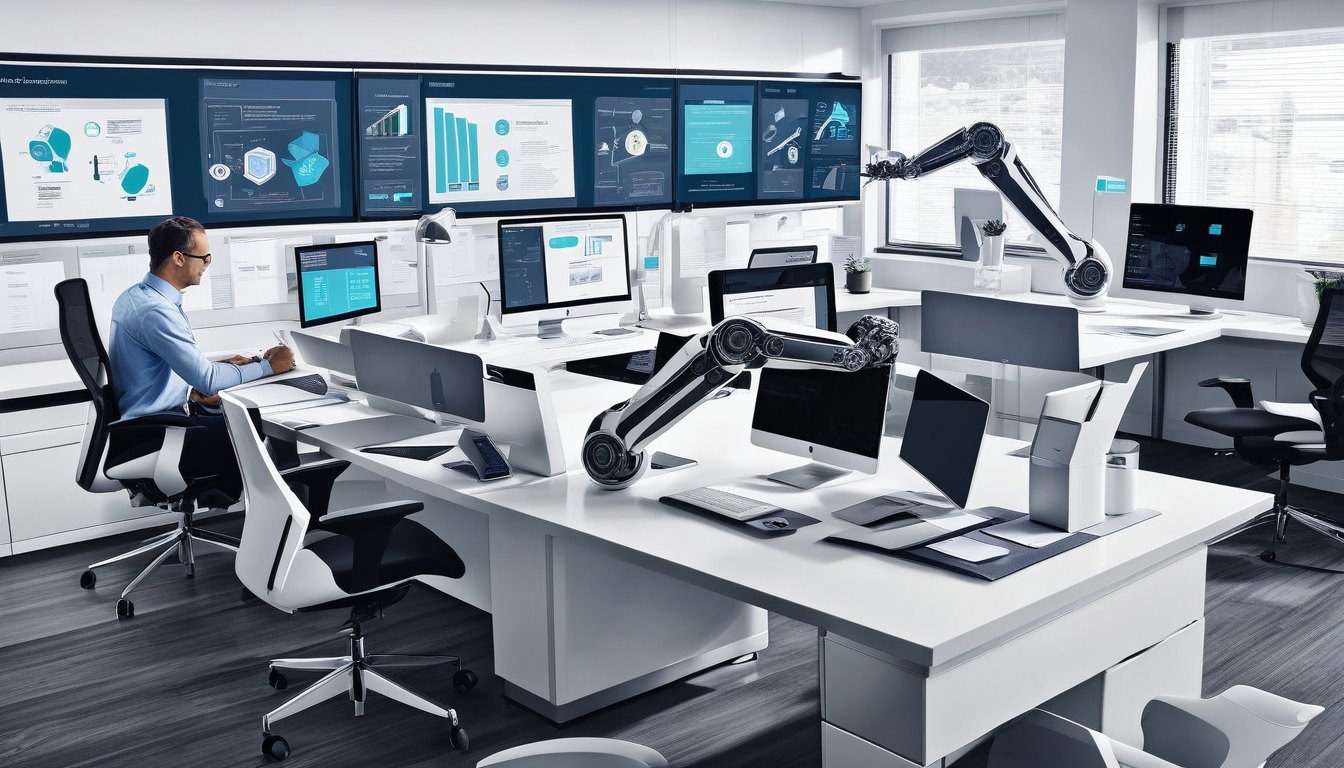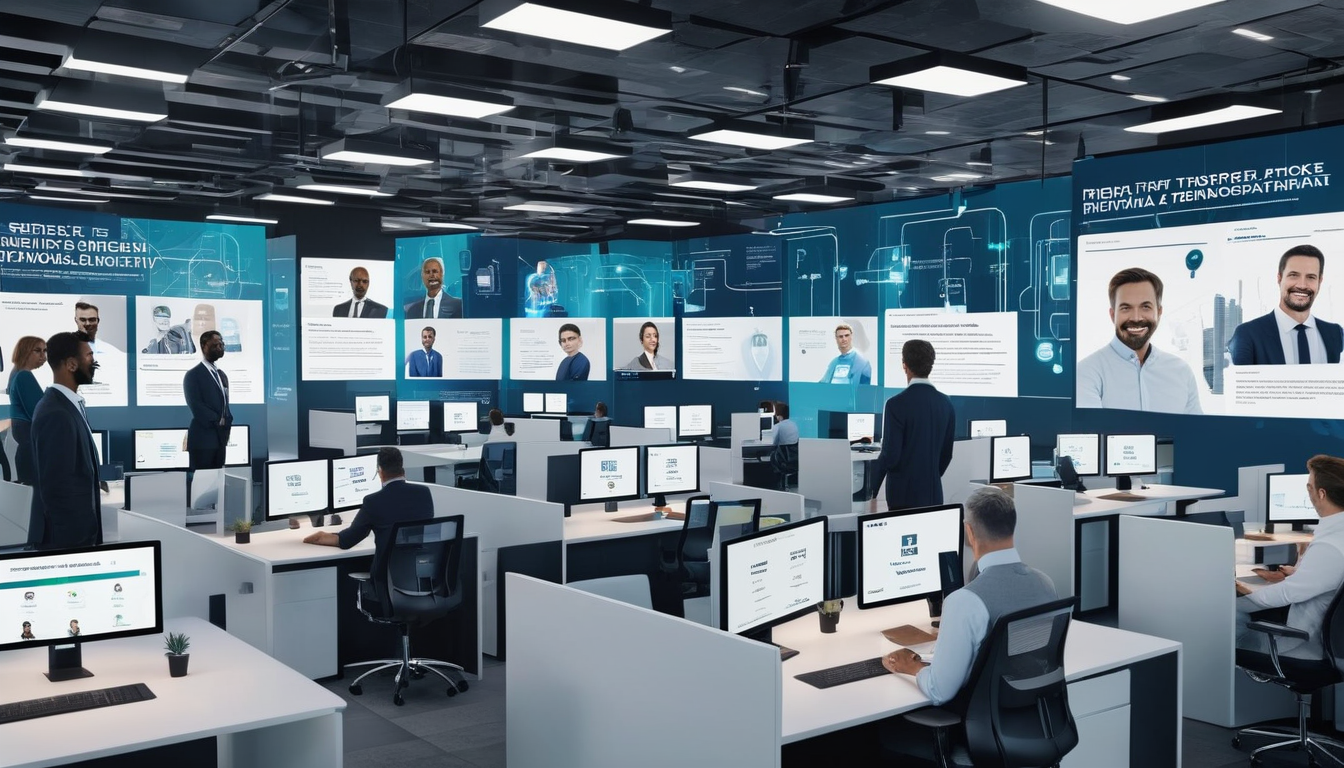10 AI Technologies That Will Change the Future of Work

This article explores ten groundbreaking AI technologies poised to reshape the workplace, enhancing productivity, collaboration, and decision-making while addressing the challenges and ethical considerations associated with their implementation. As we delve into these technologies, it’s essential to understand how they impact not just businesses but also the individuals who make up the workforce. Let’s embark on this journey to discover how AI is revolutionizing our work environments!
Machine learning algorithms analyze vast datasets to identify patterns, enabling businesses to make data-driven decisions and improve operational efficiency. This technology is revolutionizing industries by automating processes and providing predictive insights.
Natural language processing (NLP) allows machines to understand and interpret human language. This technology enhances communication tools, chatbots, and virtual assistants, streamlining interactions between employees and clients while improving customer service.
Chatbots powered by NLP can handle customer inquiries 24/7, providing instant support and reducing the workload on human agents. This technology allows businesses to enhance customer satisfaction and operational efficiency.
Various industries utilize chatbots for customer service, lead generation, and even internal communication, showcasing their versatility and effectiveness in enhancing workplace productivity.
Despite their advantages, chatbots have limitations in understanding complex queries and emotional nuances, which can affect user experience and necessitate human intervention.
Sentiment analysis tools assess customer feedback and employee sentiment, providing valuable insights into public perception and workplace morale, thus enabling proactive management strategies.
Robotic process automation (RPA) automates repetitive tasks, freeing employees to focus on higher-value work. This technology enhances productivity and accuracy while reducing operational costs.
Implementing RPA leads to significant time savings and error reduction, allowing organizations to allocate resources more effectively and improve overall business performance.
While RPA offers numerous benefits, organizations may face challenges such as change management and the need for employee reskilling to adapt to new workflows.
AI-driven analytics tools provide deeper insights into business performance, enabling companies to make informed decisions based on real-time data analysis and predictive modeling.
Predictive analytics uses historical data to forecast future trends, helping businesses anticipate market changes and customer behavior, ultimately driving strategic planning.
Data visualization tools powered by AI enhance the interpretation of complex data sets, enabling stakeholders to grasp insights quickly and make data-driven decisions effectively.
Virtual and augmented reality technologies are transforming training and collaboration by providing immersive experiences that enhance learning and engagement in the workplace.
VR and AR are increasingly used in employee training programs, offering realistic simulations that improve skill acquisition and retention, particularly in fields requiring hands-on experience.
These technologies facilitate remote collaboration by enabling virtual meetings and interactive presentations, bridging the gap between geographically dispersed teams and fostering innovation.
AI technologies are streamlining the recruitment process by automating candidate screening, enhancing diversity, and improving the overall hiring experience for both candidates and employers.
Automated screening tools analyze resumes and applications, identifying the best-fit candidates based on predefined criteria, significantly reducing the time and effort required in the hiring process.
AI can help mitigate biases in recruitment by using data-driven algorithms to ensure a fair and equitable hiring process, promoting diversity and inclusion in the workplace.
| AI Technology | Impact on Work | Challenges |
|---|---|---|
| Machine Learning | Data-driven decision making | Data privacy concerns |
| Natural Language Processing | Enhanced communication | Understanding complex queries |
| Robotic Process Automation | Increased productivity | Change management |
| AI-Driven Analytics | Informed decision making | Data security issues |
| Virtual/Augmented Reality | Immersive training experiences | High implementation costs |
| AI in Recruitment | Streamlined hiring process | Bias in algorithms |
In conclusion, these AI technologies are not just trends; they are the future of work. As we embrace these innovations, we must also consider the ethical implications and prepare our workforce for the changes ahead. The question is, are we ready to adapt and thrive in this new landscape?

1. Machine Learning
Machine learning is not just a buzzword; it’s a game-changer in the world of technology and business. Imagine having a powerful assistant that can sift through mountains of data, identify patterns, and provide insights that were previously hidden. That’s what machine learning does! By leveraging algorithms that learn from data, businesses can make data-driven decisions that enhance operational efficiency and drive growth.
This technology is revolutionizing industries across the board. From healthcare to finance, machine learning is automating processes and providing predictive insights that help organizations stay ahead of the curve. For instance, in healthcare, machine learning algorithms can analyze patient data to predict disease outbreaks or suggest personalized treatment plans. In finance, these algorithms can detect fraudulent activities by identifying unusual patterns in transaction data.
| Industry | Application of Machine Learning |
|---|---|
| Healthcare | Predictive analytics for patient outcomes |
| Finance | Fraud detection and risk assessment |
| Retail | Personalized recommendations and inventory management |
| Manufacturing | Predictive maintenance and quality control |
But what are the key benefits of implementing machine learning in your organization? Here are some highlights:
- Enhanced Decision-Making: Machine learning provides insights that help leaders make informed choices.
- Increased Efficiency: Automating routine tasks allows employees to focus on more strategic initiatives.
- Cost Reduction: By optimizing processes, businesses can reduce operational costs significantly.
However, it’s essential to address the challenges that come with adopting machine learning. Organizations must ensure they have the right data infrastructure in place and consider the ethical implications of using AI technologies. As machine learning continues to evolve, it raises questions about data privacy, job displacement, and algorithmic bias. Therefore, striking a balance between leveraging these technologies and addressing ethical concerns is crucial for sustainable growth.
In conclusion, machine learning is a powerful tool that can transform the future of work. By harnessing its capabilities, organizations can enhance productivity, improve decision-making, and stay competitive in an ever-changing landscape. As we move forward, the challenge will be to implement these technologies responsibly and ethically, ensuring that the benefits are shared across all levels of the workforce.

2. Natural Language Processing
Natural Language Processing (NLP) is a remarkable technology that enables machines to understand and interpret human language. Think of it as a bridge between humans and computers, allowing seamless communication. This technology is not just a fancy gadget; it’s a game-changer for businesses looking to enhance their communication tools, chatbots, and virtual assistants. By streamlining interactions between employees and clients, NLP significantly improves customer service and overall workplace efficiency.
Imagine a world where your customer support is available 24/7, ready to handle inquiries without the need for human agents. That’s the power of chatbots powered by NLP. These digital assistants can engage with customers instantly, providing answers to frequently asked questions, guiding them through processes, and even making recommendations. This not only enhances customer satisfaction but also reduces the workload on human agents, allowing them to focus on more complex issues.
| Use Cases of NLP | Description |
|---|---|
| Customer Service | Chatbots handle inquiries, providing instant support. |
| Lead Generation | NLP tools analyze data to identify potential leads. |
| Internal Communication | Facilitates smoother communication among team members. |
However, while the benefits are clear, it’s essential to recognize the limitations of chatbots. They often struggle with complex queries and emotional nuances, leading to potential frustrations for users. This is where human intervention becomes crucial, ensuring that customers receive the best possible experience. It’s a bit like having a super-smart assistant who can handle routine tasks but still requires a human touch for the more intricate matters.
Another fascinating aspect of NLP is sentiment analysis. This tool assesses customer feedback and employee sentiment, providing valuable insights into public perception and workplace morale. By understanding how customers feel about a product or service, businesses can adapt their strategies proactively, addressing issues before they escalate. It’s like having a pulse on your audience, allowing you to respond thoughtfully and effectively.
In conclusion, Natural Language Processing is revolutionizing how we communicate in the workplace. With its ability to enhance customer interactions and provide deep insights through sentiment analysis, NLP is not just a trend; it’s a vital component of the future of work. As organizations embrace this technology, they must also navigate its challenges, ensuring a balanced approach that maintains the human element in communication.
“The future of work is not about machines replacing humans, but about machines enhancing human capabilities.” – Industry Expert
2.1. Chatbots
Chatbots are transforming the way businesses interact with their customers. Powered by Natural Language Processing (NLP), these intelligent programs can handle customer inquiries around the clock, providing instantaneous support that significantly reduces the burden on human agents. Imagine having a tireless assistant that works 24/7, ready to answer questions, resolve issues, and enhance overall customer satisfaction. This is exactly what chatbots bring to the table!
Here’s a quick overview of how chatbots can benefit your business:
| Benefit | Description |
|---|---|
| 24/7 Availability | Chatbots can respond to customer inquiries at any time, ensuring no opportunity for engagement is missed. |
| Cost Efficiency | By automating responses, businesses can save on labor costs while maintaining high levels of service. |
| Scalability | As your business grows, chatbots can handle an increasing volume of inquiries without the need for additional staff. |
However, it’s essential to acknowledge that chatbots aren’t perfect. They face certain limitations, particularly regarding complex queries and emotional nuances. For instance, while they can manage straightforward questions like “What are your business hours?” they may struggle with more intricate inquiries that require empathy or deep understanding. This often results in situations where human intervention is necessary. Here’s a brief list of some common limitations:
- Difficulty in understanding context
- Challenges with complex customer emotions
- Potential for miscommunication
Despite these challenges, the potential of chatbots is immense. They are not just a trend; they are becoming a staple in various industries, including retail, healthcare, and finance. By streamlining customer service processes, they allow businesses to focus on what truly matters: building relationships and enhancing customer experiences.
In conclusion, as we delve deeper into the age of AI, chatbots will undoubtedly play a crucial role in reshaping workplace dynamics. They exemplify how technology can enhance productivity while addressing customer needs efficiently. It’s like having a supercharged assistant who is always on the job, ready to help, and constantly learning from interactions to improve future responses. As businesses continue to adopt this technology, the future of customer service looks brighter than ever!
2.1.1. Use Cases
Chatbots, powered by Natural Language Processing (NLP), have become indispensable tools across various industries. Their ability to handle customer inquiries and provide instant support has revolutionized the way businesses interact with their clients. Imagine a world where customer service is available 24/7, and human agents can focus on complex issues rather than repetitive tasks. This is the reality that chatbots create.
Here are some prominent use cases of chatbots in the workplace:
- Customer Service: Chatbots can answer frequently asked questions, resolve issues, and guide customers through processes, significantly reducing wait times.
- Lead Generation: By engaging potential customers on websites, chatbots can qualify leads and gather essential information, streamlining the sales process.
- Internal Communication: Chatbots can facilitate communication within teams by providing updates, reminders, and even assisting with scheduling meetings.
As you can see, chatbots are not just a trend; they are a game-changer in enhancing workplace productivity. To illustrate their impact, consider the following table that showcases how various industries utilize chatbots:
| Industry | Use Case | Benefits |
|---|---|---|
| Retail | Order Tracking | Improved customer satisfaction and reduced support costs |
| Healthcare | Appointment Scheduling | Increased efficiency and reduced administrative burden |
| Finance | Fraud Detection | Enhanced security and quicker response times |
However, while chatbots have numerous applications, they do face limitations. For instance, they may struggle with understanding complex queries or emotional nuances, which can lead to frustration for users. This is where the importance of human intervention comes into play, ensuring that customers always have access to the support they need.
In conclusion, the use cases for chatbots are vast and varied, and their integration into workplaces is proving to be a transformative force. By automating routine tasks and enhancing communication, chatbots not only improve operational efficiency but also contribute to a more satisfying experience for both employees and customers alike.
2.1.2. Limitations
While chatbots powered by Natural Language Processing (NLP) bring numerous benefits to the workplace, they are not without their limitations. One major challenge is their inability to fully comprehend complex queries or emotional nuances. This can lead to misunderstandings and frustration for users seeking assistance. For instance, a customer may express dissatisfaction in a nuanced manner, expecting empathy and understanding, which a chatbot might struggle to provide.
Additionally, chatbots often rely on pre-defined scripts and algorithms, which can limit their ability to adapt to unexpected situations. This rigidity may result in a lack of personalized responses, making interactions feel robotic rather than human. Here are some common limitations faced by chatbots:
- Complex Queries: Chatbots can falter when faced with intricate or multi-part questions.
- Emotional Intelligence: They lack the ability to interpret feelings or emotional context effectively.
- Learning Curve: Continuous learning and adaptation can be challenging without human oversight.
To illustrate these limitations, consider the following table that highlights the differences between chatbot capabilities and human interaction:
| Aspect | Chatbot | Human Agent |
|---|---|---|
| Understanding Complex Queries | Poor | Excellent |
| Emotional Intelligence | Limited | High |
| Response Personalization | Standardized | Tailored |
| Adaptability | Low | High |
These limitations underscore the importance of having a balanced approach to customer service. While chatbots can handle routine inquiries and provide quick responses, they should be complemented by human agents who can address more complex concerns. In this way, businesses can leverage the strengths of both technologies to enhance customer satisfaction while maintaining a high level of service quality.
In conclusion, while chatbots are a revolutionary tool in enhancing workplace productivity and customer engagement, it is crucial for organizations to acknowledge their limitations. By doing so, they can develop strategies that integrate both AI technologies and human expertise, ensuring a seamless and effective customer experience.
2.2. Sentiment Analysis
Sentiment analysis is a powerful tool that enables organizations to gauge the emotional tone behind a series of words. By utilizing advanced algorithms, businesses can extract insights from customer feedback, social media interactions, and employee surveys. This technology not only helps in understanding public perception but also plays a crucial role in enhancing workplace morale. Imagine being able to listen to the voice of your employees or customers without having to sift through countless reviews or comments. That’s the magic of sentiment analysis!
The process involves several key steps, including data collection, processing, and analysis. Here’s a brief overview of how sentiment analysis works:
| Step | Description |
|---|---|
| Data Collection | Gathering data from various sources such as social media, surveys, and customer feedback. |
| Data Processing | Cleaning and preparing the data for analysis, removing noise, and irrelevant information. |
| Analysis | Using algorithms to determine the sentiment (positive, negative, or neutral) expressed in the data. |
| Reporting | Generating reports that provide insights into customer and employee sentiments. |
By leveraging sentiment analysis, organizations can proactively manage their strategies. For instance, if a significant number of employees express dissatisfaction in surveys, management can address the underlying issues before they escalate. Similarly, understanding customer sentiment can lead to improved products and services, fostering loyalty and satisfaction.
Here are some key benefits of implementing sentiment analysis in the workplace:
- Improved Communication: Understanding sentiment helps tailor communication strategies to resonate better with audiences.
- Enhanced Employee Engagement: By monitoring employee sentiment, companies can create a more positive work environment.
- Data-Driven Decisions: Insights from sentiment analysis can inform strategic decisions, leading to better outcomes.
In conclusion, sentiment analysis is not just a buzzword; it’s a vital component of modern business strategy. As organizations strive to create a more inclusive and responsive workplace, harnessing the power of sentiment analysis can lead to a significant competitive advantage. Remember, in the words of an anonymous source, “The greatest asset of a company is its people.” Understanding their sentiments is the first step toward fostering a thriving work culture.

3. Robotic Process Automation
Robotic Process Automation (RPA) is a game-changer in the world of business operations. By automating repetitive and mundane tasks, RPA allows employees to focus on more strategic initiatives that require human creativity and problem-solving skills. Imagine a workplace where tedious data entry, invoice processing, and report generation are handled by software robots, freeing up valuable time for employees to engage in high-impact projects. This transformation not only boosts productivity but also enhances job satisfaction.
The implementation of RPA can lead to significant operational improvements. For instance, organizations can expect:
- Increased Efficiency: Automation of routine tasks reduces the time taken to complete processes.
- Cost Reduction: Minimizing human error lowers costs associated with mistakes and rework.
- Scalability: RPA solutions can be easily scaled to meet changing business needs.
However, transitioning to RPA isn’t without its challenges. Companies must consider the following:
| Challenges | Solutions |
|---|---|
| Change Management | Implement a robust change management strategy to help employees adapt. |
| Employee Reskilling | Provide training programs to equip employees with new skills for higher-value tasks. |
| Integration with Existing Systems | Ensure RPA tools are compatible with current software and processes. |
As organizations embrace RPA, they are not just optimizing their processes; they are also redefining the role of their workforce. Employees can transition from performing repetitive tasks to engaging in more meaningful work that drives innovation and growth. This shift can lead to a more motivated workforce, as employees feel their contributions are valued and impactful.
In conclusion, Robotic Process Automation is revolutionizing the workplace by enhancing productivity and accuracy while simultaneously reducing operational costs. Companies that successfully navigate the challenges of RPA implementation will find themselves at a competitive advantage, equipped to thrive in an ever-evolving business landscape. As one expert puts it, “The future of work is not about machines replacing humans; it’s about humans working alongside machines to achieve greater things.” Embracing this technology is not just an option; it’s becoming a necessity for businesses aiming to stay relevant in the digital age.
3.1. Benefits of RPA
Robotic Process Automation (RPA) is a game-changer for businesses looking to streamline their operations and boost productivity. By automating repetitive tasks, RPA allows employees to focus on more strategic and creative work, which can lead to significant improvements in overall efficiency. Imagine a world where mundane tasks like data entry and invoice processing are handled by robots, freeing up your team’s time for innovation and problem-solving. This is not just a dream; it’s a reality that many organizations are already experiencing.
The benefits of RPA are substantial and can be categorized into several key areas:
- Time Savings: RPA can perform tasks much faster than humans, reducing the time taken for processes that typically consume a lot of hours.
- Cost Reduction: By minimizing the need for manual labor, businesses can significantly cut down on operational costs.
- Accuracy Improvement: Robots are less prone to errors compared to humans, leading to higher quality outputs.
- Scalability: RPA systems can be easily scaled up or down based on business needs, ensuring flexibility in operations.
To illustrate the benefits of RPA, consider the following table that highlights how various industries have leveraged this technology to enhance their operations:
| Industry | RPA Application | Benefit |
|---|---|---|
| Finance | Automated reconciliation of accounts | Increased accuracy and reduced processing time |
| Healthcare | Patient data management | Improved patient care and reduced administrative burden |
| Retail | Inventory management | Enhanced stock accuracy and faster order fulfillment |
In summary, the implementation of RPA not only leads to significant time and cost savings but also enhances accuracy and scalability across various industries. As companies continue to embrace this transformative technology, they will find themselves better equipped to adapt to the ever-evolving market demands. It’s not just about doing things faster; it’s about doing things smarter, and RPA is paving the way for a more efficient future.
“Automation is not just a tool for efficiency; it’s a catalyst for innovation.” – Industry Expert
3.2. Challenges of RPA
While Robotic Process Automation (RPA) offers numerous benefits, it is not without its challenges. Organizations looking to implement RPA must navigate a variety of obstacles that can impact the success of their automation initiatives. One of the primary challenges is change management. Employees may resist the introduction of RPA due to fears of job displacement or a lack of understanding of how these technologies can enhance their roles. To combat this, effective communication and training are essential.
Another significant challenge is the need for employee reskilling. As RPA takes over repetitive tasks, employees will need to adapt to new workflows and learn to work alongside these automated systems. This transition can be time-consuming and requires a commitment from both management and staff to foster a culture of continuous learning.
| Challenge | Impact | Solution |
|---|---|---|
| Change Management | Resistance from employees | Effective communication and training |
| Employee Reskilling | Need for new skills and adaptation | Ongoing training programs |
| Integration with Legacy Systems | Compatibility issues | Invest in modern infrastructure |
| Data Security Concerns | Risk of data breaches | Implement robust security protocols |
Moreover, integrating RPA with existing legacy systems can pose a challenge. Many organizations still rely on outdated technology that may not be compatible with modern automation tools. This can lead to increased costs and delays in implementation. To address this, companies should consider investing in modern infrastructure that can seamlessly integrate with RPA solutions.
Finally, data security concerns cannot be overlooked. As organizations automate processes that involve sensitive information, the risk of data breaches increases. It is crucial for businesses to implement robust security protocols to protect their data and maintain customer trust. In summary, while RPA can significantly enhance productivity, organizations must be prepared to address these challenges to fully realize its potential.
In conclusion, embracing RPA is akin to navigating a new landscape; it requires careful planning, open communication, and a willingness to adapt. By proactively managing these challenges, organizations can harness the transformative power of RPA, paving the way for a more efficient and innovative future.

4. AI-Driven Analytics
AI-driven analytics is revolutionizing the way businesses interpret and utilize data. By leveraging advanced algorithms, these tools provide deeper insights into business performance, enabling companies to make informed decisions based on real-time data analysis and predictive modeling. Imagine having a crystal ball that not only tells you what has happened but also forecasts what is likely to happen next. This is precisely what AI-driven analytics offers—transforming raw data into actionable insights.
One of the standout features of AI-driven analytics is its ability to process vast amounts of data at lightning speed. Traditional analytics can be time-consuming and often requires manual intervention to derive meaningful conclusions. In contrast, AI tools can automate this process, allowing businesses to focus on strategic initiatives rather than getting bogged down in data crunching. The result? Enhanced operational efficiency and a more agile approach to decision-making.
| Feature | Description |
|---|---|
| Real-Time Data Analysis | Allows businesses to make decisions based on the most current data available. |
| Predictive Modeling | Forecasts future trends based on historical data, helping businesses anticipate market changes. |
| Automated Reporting | Simplifies the reporting process, providing stakeholders with easy-to-understand visualizations. |
Furthermore, predictive analytics is a game-changer in this realm. By using historical data, it helps businesses forecast future trends, customer behavior, and even potential market shifts. This foresight is invaluable for strategic planning and can significantly influence a company’s competitive edge. For instance, retailers can predict inventory needs, while financial institutions can assess risk more accurately.
Another aspect of AI-driven analytics is data visualization. These tools transform complex data sets into visually appealing graphics that are easy to interpret. Stakeholders can quickly grasp insights and make data-driven decisions without wading through endless spreadsheets. Whether it’s through interactive dashboards or engaging infographics, the emphasis is on clarity and accessibility.
In summary, AI-driven analytics is not just a trend; it’s a necessity for businesses looking to thrive in today’s data-driven world. By harnessing the power of AI, organizations can unlock new levels of efficiency and insight that were previously unimaginable. As we move forward, the challenge will be to integrate these technologies ethically and effectively, ensuring that the benefits of AI are realized without compromising on values.
As we embrace the future, remember that AI-driven analytics is more than just a tool; it’s a partner in your journey towards success. So, are you ready to let AI illuminate your path?
4.1. Predictive Analytics
Predictive analytics is a game-changer in the business world, leveraging historical data to forecast future trends and behaviors. Imagine having a crystal ball that not only tells you what might happen next but also guides your strategic decisions! This powerful technology uses advanced statistical algorithms and machine learning techniques to analyze past data, uncover patterns, and predict outcomes.
Businesses can utilize predictive analytics in various ways, such as:
- Market Trend Analysis: By examining historical sales data, companies can identify trends and seasonal patterns, allowing them to adjust their strategies accordingly.
- Customer Behavior Prediction: Understanding how customers are likely to behave helps businesses tailor their marketing efforts and improve customer satisfaction.
- Risk Management: Predictive analytics can identify potential risks and vulnerabilities, enabling organizations to implement proactive measures.
To illustrate the impact of predictive analytics, consider the following table that showcases how different industries apply this technology:
| Industry | Application | Benefits |
|---|---|---|
| Retail | Inventory Management | Optimized stock levels and reduced waste |
| Finance | Credit Scoring | Better risk assessment and lower default rates |
| Healthcare | Patient Outcome Prediction | Improved patient care and resource allocation |
By harnessing the power of predictive analytics, companies can make informed decisions that not only enhance their operational efficiency but also drive innovation. As businesses continue to evolve, the ability to predict future trends will become increasingly vital. In fact, a recent study found that organizations using predictive analytics are 5 times more likely to make faster decisions than those that don’t.
In conclusion, predictive analytics is not just a tool; it’s a strategic asset that can propel businesses into the future. As we embrace this technology, the question isn’t whether to adopt it, but rather how quickly we can integrate it into our workflows to stay ahead of the competition.
4.2. Data Visualization
In today’s fast-paced business environment, data visualization has become an essential tool for organizations aiming to make sense of complex datasets. By transforming raw data into visually engaging formats, such as charts, graphs, and dashboards, businesses can quickly identify trends, patterns, and outliers that might otherwise go unnoticed. This not only enhances decision-making but also fosters a culture of data-driven insights within the company.
Imagine trying to decipher a dense spreadsheet filled with numbers—it’s like finding a needle in a haystack! With effective data visualization, that same data can be displayed in a way that tells a story, making it easier for stakeholders to grasp the key points at a glance. For instance, a well-designed bar chart can instantly convey sales performance over time, allowing teams to adjust strategies accordingly.
| Type of Visualization | Use Case | Benefits |
|---|---|---|
| Bar Chart | Comparing sales across different regions | Easy comparison and trend identification |
| Pie Chart | Market share analysis | Visual representation of proportions |
| Heat Map | Customer engagement analysis | Identifies hotspots of activity |
Moreover, the integration of AI-driven tools into data visualization enhances the ability to interpret data. These tools can automatically generate visual representations based on the data patterns they detect, saving valuable time and reducing human error. For example, platforms like Tableau and Power BI leverage AI to suggest the most effective visualization formats based on the data being analyzed.
However, while the benefits are clear, organizations must also be mindful of potential pitfalls. Overloading visualizations with too much information can lead to confusion rather than clarity. To avoid this, it’s essential to focus on the key messages that need to be communicated. Here are some tips for effective data visualization:
- Keep it simple: Avoid clutter and focus on the essential data points.
- Choose the right type of visualization: Select a format that best represents the data.
- Use color wisely: Colors should enhance understanding, not distract from it.
In conclusion, data visualization is not just about making data pretty; it’s about making it accessible and actionable. As organizations continue to rely on data to drive their strategies, mastering the art of data visualization will be crucial for maintaining a competitive edge in the marketplace. Remember, a picture is worth a thousand words, and in the world of business, it could be worth millions!

5. Virtual and Augmented Reality
Virtual and Augmented Reality (VR and AR) technologies are not just buzzwords; they are revolutionizing the way we approach training, collaboration, and engagement in the workplace. Imagine stepping into a fully immersive environment where you can practice skills as if you were in a real-world scenario, or collaborating with colleagues from around the globe as if they were right next to you. This is the power of VR and AR, and it’s changing the future of work.
One of the most significant applications of these technologies is in employee training. Traditional training methods often fall short in providing real-life experiences. With VR, employees can engage in realistic simulations that enhance their learning experience. For instance, medical professionals can practice surgeries without the risk of harming patients, while engineers can explore complex machinery in a virtual space. The benefits of using VR in training include:
- Enhanced Skill Acquisition: Employees can repeatedly practice tasks until they achieve proficiency.
- Improved Retention: Immersive experiences help in better memory retention compared to conventional methods.
- Cost-Effective: Reduces the need for physical materials and resources.
Moreover, AR is making waves in collaboration tools. As remote work becomes more prevalent, the need for effective communication and teamwork grows. AR allows teams to interact with 3D models and data visualizations in real-time, regardless of their physical locations. For example, during a product design meeting, team members can manipulate a virtual prototype, providing instant feedback and fostering innovation.
| Technology | Applications in Workplace | Benefits |
|---|---|---|
| Virtual Reality | Employee training, simulations | Enhanced learning, risk-free practice |
| Augmented Reality | Remote collaboration, interactive presentations | Real-time interaction, improved engagement |
While the potential of VR and AR is immense, it’s essential to consider the challenges associated with their implementation. Not all employees may feel comfortable using these technologies, and there can be a steep learning curve. Organizations must invest in proper training and support to ensure everyone is on board.
In conclusion, Virtual and Augmented Reality are set to transform how we work, learn, and collaborate. By embracing these technologies, businesses can create more engaging, effective, and innovative environments. As we move forward, it will be exciting to see how these tools continue to evolve and shape the future of work.
“The future belongs to those who believe in the beauty of their dreams.” – Eleanor Roosevelt
5.1. Training Applications
In today’s fast-paced work environment, training applications powered by Virtual Reality (VR) and Augmented Reality (AR) are becoming essential tools for organizations aiming to enhance employee skill sets. These immersive technologies provide realistic simulations that allow employees to practice and refine their abilities in a safe and controlled setting. Imagine being able to step into a virtual world where you can interact with your environment just like you would in real life—this is the future of training!
One of the most significant advantages of using VR and AR in training is the ability to create engaging and interactive learning experiences. Traditional training methods often fall short in keeping employees motivated, but with the incorporation of immersive technologies, learning becomes an adventure. For instance, in industries such as healthcare, employees can practice complex procedures without the risk of harming patients. Similarly, in manufacturing, workers can familiarize themselves with machinery in a virtual space before operating it in reality.
| Industry | Training Application | Benefits |
|---|---|---|
| Healthcare | Virtual surgeries and patient interactions | Enhanced skill retention and reduced risk |
| Manufacturing | Machine operation simulations | Increased safety and confidence |
| Retail | Customer service scenarios | Improved communication skills |
| Aerospace | Flight simulations | Realistic training for pilots |
Moreover, these training applications are not just about learning; they also foster a sense of collaboration among employees. Teams can engage in joint training sessions, bridging the gap between different locations and time zones. As companies embrace remote work, the ability to conduct training in a virtual environment becomes invaluable.
However, it’s essential to recognize that while VR and AR offer numerous benefits, they also come with challenges. Implementing these technologies requires a significant investment in both hardware and software, as well as the development of high-quality training content. Organizations must also ensure that their employees are comfortable using these new tools, which may require additional training and support.
In conclusion, the integration of VR and AR in training applications is revolutionizing how organizations prepare their workforce for the challenges of tomorrow. By providing immersive and interactive experiences, these technologies not only enhance skill acquisition but also promote a culture of continuous learning. As we look to the future, it’s clear that embracing these innovations will be crucial for companies aiming to stay competitive in an ever-evolving landscape.
“The only way to do great work is to love what you do.” – Steve Jobs
5.2. Collaboration Tools
In today’s fast-paced work environment, collaboration tools have become essential for fostering teamwork and innovation, especially in remote settings. These tools not only bridge the gap between geographically dispersed teams but also enhance productivity by streamlining communication. Imagine being able to brainstorm ideas, share documents, and hold meetings without ever leaving your desk! With the rise of virtual and augmented reality, the possibilities for collaborative experiences are expanding rapidly.
One of the key features of modern collaboration tools is their ability to integrate seamlessly with other applications. This interoperability allows teams to work more efficiently by centralizing their resources. For example, platforms like Slack or Microsoft Teams enable users to communicate in real-time while sharing files from cloud storage services like Google Drive or Dropbox. The result? A cohesive workflow that keeps everyone on the same page.
Moreover, the use of collaboration tools can significantly enhance engagement during meetings. Virtual reality (VR) and augmented reality (AR) applications provide immersive environments where team members can interact as if they were physically present together. This not only makes meetings more enjoyable but also encourages participation from all members, regardless of their location.
| Collaboration Tool | Key Features | Best For |
|---|---|---|
| Slack | Real-time messaging, file sharing, integrations | Small to medium-sized teams |
| Microsoft Teams | Video conferencing, document collaboration, task management | Corporate environments |
| Trello | Task management, boards, lists, and cards | Project management |
| Zoom | Video conferencing, webinars, screen sharing | Large meetings and presentations |
While these tools offer numerous advantages, it’s important to recognize potential drawbacks as well. Over-reliance on technology can sometimes lead to miscommunication or misunderstandings. Therefore, it’s crucial to establish clear guidelines for usage and ensure that all team members are adequately trained to utilize these platforms effectively.
In conclusion, collaboration tools are transforming the way we work together. By embracing these technologies, organizations can enhance communication, foster creativity, and ultimately drive success in an increasingly digital world. As we move forward, it will be fascinating to see how these tools evolve and continue to shape the future of collaboration.

6. AI in Recruitment
In today’s fast-paced world, AI in recruitment is not just a trend—it’s a revolutionary approach that is transforming how companies find and hire talent. Imagine a scenario where the tedious and often biased process of sorting through hundreds of resumes is streamlined and made more efficient through advanced algorithms. This is the power of AI! By automating candidate screening, AI tools not only save time but also enhance the overall hiring experience for both candidates and employers.
One of the most significant advantages of AI in recruitment is its ability to analyze vast amounts of data quickly. For instance, automated screening tools can sift through resumes and applications with pinpoint accuracy, identifying the best-fit candidates based on predefined criteria. This means that recruiters can focus more on engaging with potential hires rather than getting bogged down by paperwork. Here’s how it works:
| Feature | Description |
|---|---|
| Automated Screening | AI tools analyze resumes for keywords and qualifications, speeding up the selection process. |
| Bias Mitigation | Data-driven algorithms help ensure a fair and equitable hiring process, promoting diversity. |
| Enhanced Candidate Experience | Streamlined processes lead to quicker feedback and improved communication with candidates. |
Additionally, AI can help mitigate biases in recruitment. Traditional hiring processes often suffer from unconscious bias, which can lead to a lack of diversity within teams. By utilizing data-driven algorithms, AI ensures that candidates are evaluated based on their skills and experience rather than their background. This not only promotes a more inclusive workplace but also fosters innovation by bringing diverse perspectives to the table.
Moreover, the use of AI in recruitment can significantly enhance the candidate experience. Candidates today expect quick feedback and a seamless application process. With AI, companies can provide real-time updates and maintain open lines of communication, making the hiring experience more engaging. It’s like having a personal assistant guiding candidates through every step of the process!
In conclusion, the integration of AI in recruitment is a game-changer for organizations looking to optimize their hiring processes. With its ability to automate screening, reduce bias, and enhance candidate interactions, AI not only improves operational efficiency but also contributes to building a more diverse and inclusive workforce. As we continue to embrace these technologies, the future of recruitment looks brighter and more equitable than ever before.
6.1. Automated Screening
In today’s fast-paced job market, automated screening has emerged as a game-changer for recruiters and hiring managers alike. This technology leverages artificial intelligence to streamline the recruitment process, making it quicker and more efficient. Imagine sifting through hundreds of resumes in a matter of minutes—sounds like a dream, right? Well, with automated screening, this dream is now a reality. By utilizing complex algorithms, automated systems can analyze resumes, identify key qualifications, and match candidates to job descriptions with remarkable accuracy.
One of the primary benefits of automated screening is its ability to significantly reduce the time and effort required in the hiring process. Traditional methods often involve tedious manual reviews, which can lead to delays and missed opportunities. In contrast, automated systems can perform initial screenings based on predefined criteria, allowing recruiters to focus on the most promising candidates. This not only enhances efficiency but also improves the overall quality of hires.
Here are some key features of automated screening systems:
- Keyword Matching: The system scans for specific keywords related to skills, experience, and qualifications.
- Ranking Candidates: Candidates are ranked based on their fit for the position, allowing recruiters to prioritize their outreach.
- Bias Reduction: Automated tools can help minimize human biases by focusing solely on data, promoting a more equitable hiring process.
To illustrate the impact of automated screening, consider the following table, which compares traditional screening methods with automated systems:
| Aspect | Traditional Screening | Automated Screening |
|---|---|---|
| Time Required | Days to Weeks | Minutes to Hours |
| Human Bias | High | Reduced |
| Candidate Engagement | Low | High |
As illustrated, the advantages of automated screening are substantial. However, it’s essential to note that while these systems are incredibly efficient, they are not without their challenges. For instance, automated tools can sometimes overlook nuances in a candidate’s experience or potential, which may require human intervention later in the process. Therefore, the best approach often combines the speed of automation with the critical eye of a human recruiter.
In conclusion, automated screening is revolutionizing the recruitment landscape. By embracing this technology, organizations can not only enhance their hiring processes but also ensure they attract the best talent available. As we continue to integrate AI into various aspects of business, the future of hiring looks brighter than ever.
6.2. Bias Mitigation
In the realm of recruitment, bias mitigation is a crucial aspect that organizations must address to ensure a fair and equitable hiring process. Traditional hiring methods are often influenced by unconscious biases, which can lead to a lack of diversity and hinder the potential of an organization. Fortunately, AI technologies are stepping in to revolutionize this process. By leveraging data-driven algorithms, AI can help eliminate biases that may arise from human judgment.
For instance, automated screening tools can analyze resumes and applications based on predefined criteria that focus solely on qualifications and experience, rather than personal characteristics. This not only streamlines the hiring process but also promotes a more diverse and inclusive workplace. The following table highlights some of the key advantages of using AI for bias mitigation in recruitment:
| Advantage | Description |
|---|---|
| Objective Evaluation | AI evaluates candidates based on data and qualifications, reducing the influence of personal biases. |
| Diversity Enhancement | By focusing on skills and experience, AI can help organizations attract a more diverse pool of candidates. |
| Efficiency | Automated processes save time for HR teams, allowing them to focus on strategic initiatives rather than administrative tasks. |
Moreover, AI can continuously learn from data, which means it can adapt its algorithms to further reduce biases over time. However, it’s essential to note that the effectiveness of AI in bias mitigation largely depends on the quality of the data fed into these systems. If the data reflects existing biases, AI can inadvertently perpetuate them.
Here are some best practices for organizations to ensure effective bias mitigation through AI:
- Data Quality: Ensure that the data used for training AI models is diverse and representative of the population.
- Regular Audits: Conduct regular audits of AI systems to identify and rectify any biases that may have emerged.
- Human Oversight: Maintain human oversight in the recruitment process to complement AI decisions with human judgment.
In conclusion, while AI technologies offer significant potential for bias mitigation in recruitment, organizations must approach their implementation with care. By focusing on data quality and maintaining human oversight, companies can harness the power of AI to create a more equitable hiring process that not only attracts top talent but also fosters a vibrant and diverse workplace culture.
Frequently Asked Questions
- What is machine learning and how does it impact businesses?
Machine learning is a subset of AI that enables systems to learn from data and improve over time without being explicitly programmed. It impacts businesses by analyzing vast datasets to identify patterns, which helps in making data-driven decisions and improving operational efficiency.
- How do chatbots enhance customer service?
Chatbots, powered by natural language processing, can handle customer inquiries 24/7, providing instant support and reducing the workload on human agents. This leads to enhanced customer satisfaction and allows businesses to operate more efficiently.
- What are the benefits of robotic process automation (RPA)?
RPA automates repetitive tasks, which frees up employees to focus on higher-value work. The benefits include significant time savings, reduced errors, and improved overall business performance by allowing organizations to allocate resources more effectively.
- How does AI-driven analytics help in decision-making?
AI-driven analytics tools provide deeper insights into business performance through real-time data analysis and predictive modeling. This enables companies to make informed decisions by anticipating market changes and customer behavior.
- What role does virtual reality (VR) play in employee training?
VR provides immersive training experiences that enhance learning and engagement. It allows employees to practice skills in realistic simulations, which is particularly beneficial in fields that require hands-on experience.
- How is AI used in the recruitment process?
AI streamlines the recruitment process by automating candidate screening and enhancing diversity. Automated screening tools analyze resumes to identify the best-fit candidates, significantly reducing the time and effort required in hiring.
- Can AI help mitigate biases in hiring?
Yes, AI can help mitigate biases by using data-driven algorithms that ensure a fair and equitable hiring process. This promotes diversity and inclusion within the workplace, making the recruitment process more transparent.













